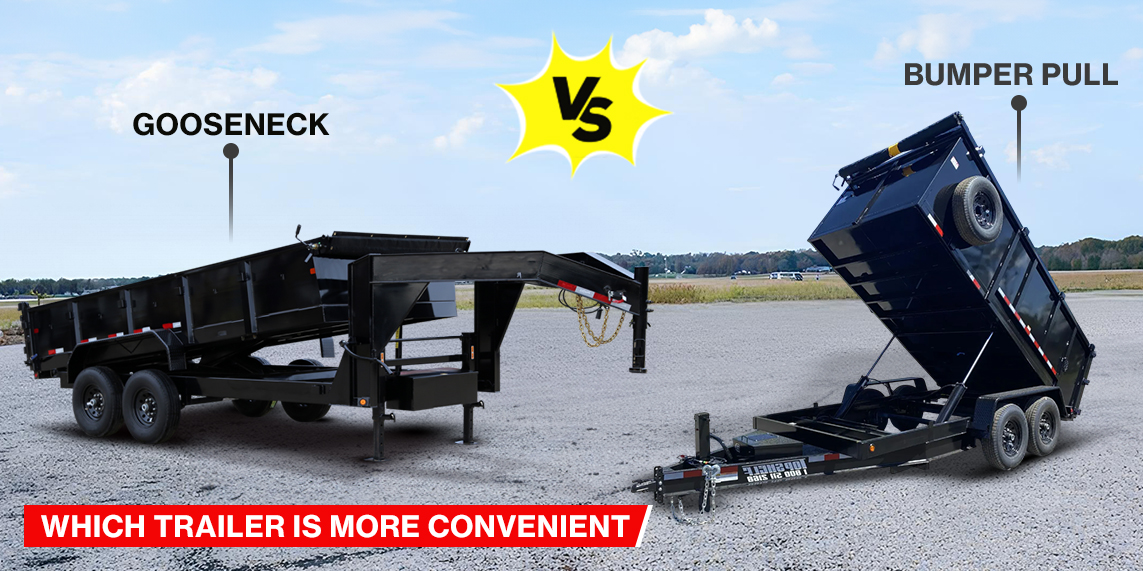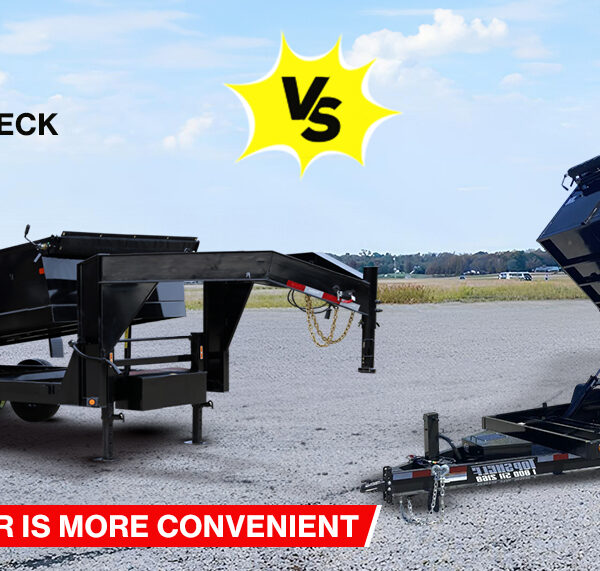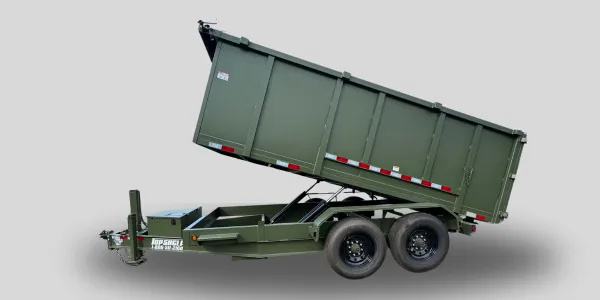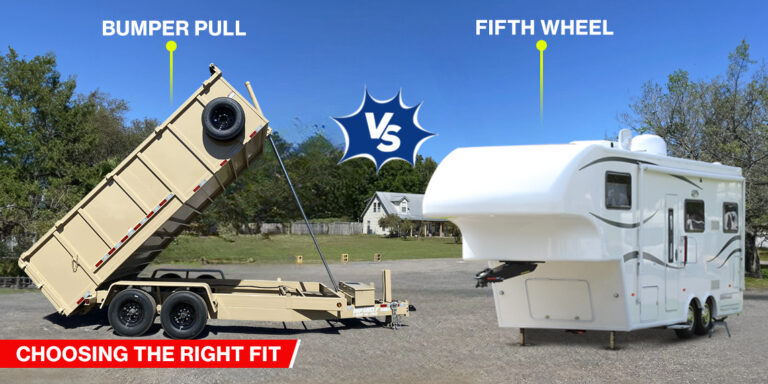Trailers have become handy additions for people of varied businesses that need hefty hauling. From packing and moving to transporting livestock or construction elements, trailers are a lucrative investment.
Now, quite a few types of trailers are available in the market. Gooseneck, bumper pull, drop deck, flatbed, bottom dump – endless names, each with unique properties worth consideration. So, which one is the ideal trailer option for your needs?
In this comprehensive read, let us compare two of the most popular trailer options in the market: gooseneck and bumper pull. While both hold the highest selling numbers, the debate of gooseneck or bumper pull has long stood among trailer enthusiasts.
Let us explore the advantages and disadvantages of each and determine the ideal trailer for hauling needs.
Gooseneck vs Bumper Pull – The Ultimate Comparison
The choice of trailer depends on the type of cargo you deal with. Both gooseneck and bumper pull trailers can effortlessly manage immense loads and are great for beginners. However, the primary difference is how the trailer connects to the towing vehicle.
As a business owner, you must understand how beneficial trailers are. They are the unsung heroes amidst the fast-growing supply chain across the industry.
Therefore, it is mandatory to understand the fundamental mechanism of the trailers before investing in either a gooseneck or bumper pull trailer.
| Feature | Gooseneck Trailer | Bumper Pull Trailer |
| Towing Capacity | High | Moderate |
| Stability | Very stable (reduced sway) | Less stable (potential sway) |
| Maneuverability | Tight turning radius | Wider turning radius |
| Cost | Higher | Lower |
| Common Use Cases | Livestock, heavy machinery | Boats, campers, light loads |
What is a Bumper Pull Trailer?
A bumper pull trailer is a classic hitch for everyday hauling and is the most common and recognizable type. It is named after how it connects to the tow vehicle. Here is a breakdown of its key features –
Hitch Connection:
The trailer’s tongue connects to a standard ball hitch and protrudes from the tow vehicle’s frame near the bumper. The feature allows easy attachment and detachment.
Compact Design:
Bumper pull trailers are typically short and narrow, delivering a greater advantage in maneuverability in tight spaces.
Cost-Effective:
They are generally less expensive to purchase and maintain, making them a premium choice among beginners.
Ease of Towing:
Bumper pulls are considered easier to tow, especially for beginners, as they follow the path of the tow vehicle when turning.
Common Uses of a Bumper Pull Trailer
Bumper pull trailers are versatile and used for a variety of purposes, including –
- Hauling boats, campers, and RVs
- Transporting motorcycles, ATVs, and dirt bikes
- Moving furniture and appliances
- Carrying equipment for work or hobbies
Key Considerations for Bumper Pull Trailers
If you are planning to opt for a bumper pull trailer for your business, here are some key factors to consider and assess –
- Tow Vehicle Capacity:
The tow vehicle must be able to handle the weight of the trailer and its contents. - Trailer Size and Weight:
The trailer’s size and weight should match the tow vehicle’s capabilities. - Maneuverability:
When choosing a bumper pull, consider the trailer’s length and turning radius, especially if you will be managing it in tight spaces. - Hitch Type:
Ensure the tow vehicle has the correct hitch type for the trailer. Learn about the various trailer hitches for towing.
Bumper pull trailers are a reliable and affordable option for many hauling needs. Their simplicity, versatility, and ease of towing make them popular for both personal and commercial use.
What is a Gooseneck Trailer?
The next variant we must learn about is a gooseneck trailer, which is a powerful hauling solution for many. The gooseneck version is typically a heavy-duty towing option designed for transporting large, bulky, or exceptionally heavy loads. It is favored for its stability, high towing capacity, and superior maneuverability compared to bumper-pull trailers.
Here are the key features of a widely available gooseneck trailer –
Hitch Connection:
The trailer’s tongue connects to a ball hitch mounted in the bed of the tow vehicle, typically over the rear axle. The central attachment point provides excellent weight distribution and stability.
High Towing Capacity:
Gooseneck trailers can handle significantly more weight than bumper-pull trailers, making them suitable for hauling large equipment, livestock, and heavy machinery.
Enhanced Maneuverability:
The close coupling to the tow vehicle results in a tighter turning radius, making it easier to navigate tight spaces.
Stability:
The centered weight distribution and strong hitch connection minimize trailer sway, even at higher speeds.
Common Uses for Gooseneck Trailers
Similar to a bumper pull trailer, gooseneck trailers have versatile use cases –
- Agriculture: Transporting tractors, combines, hay bales, and livestock.
- Construction: Hauling heavy equipment, construction materials, and large machinery.
- Recreation: Towing large RVs, horse trailers, and boats.
Considerations for Using a Gooseneck Trailer
If you have decided to purchase a gooseneck trailer, we suggest taking note of the following key factors –
Tow Vehicle Requirements:
The tow vehicle must have a high towing capacity, and adding a gooseneck hitch to the truck requires professional guidance.
Maneuverability:
While more maneuverable than bumper-pull trailers, gooseneck trailers still require careful maneuvering in tight spaces.
Cost:
Gooseneck trailers are generally more expensive than bumper-pull trailers.
Truck Bed Access:
The gooseneck hitch limits access to the truck bed.
In this battle of Gooseneck vs bumper pull trailers, the gooseneck ones are powerful and versatile towing solutions for those who need to transport heavy or bulky loads. Their stability, high towing capacity, and enhanced maneuverability make them a preferred choice for various industries and recreational activities.
Gooseneck vs Bumper Pull: Pros and Cons
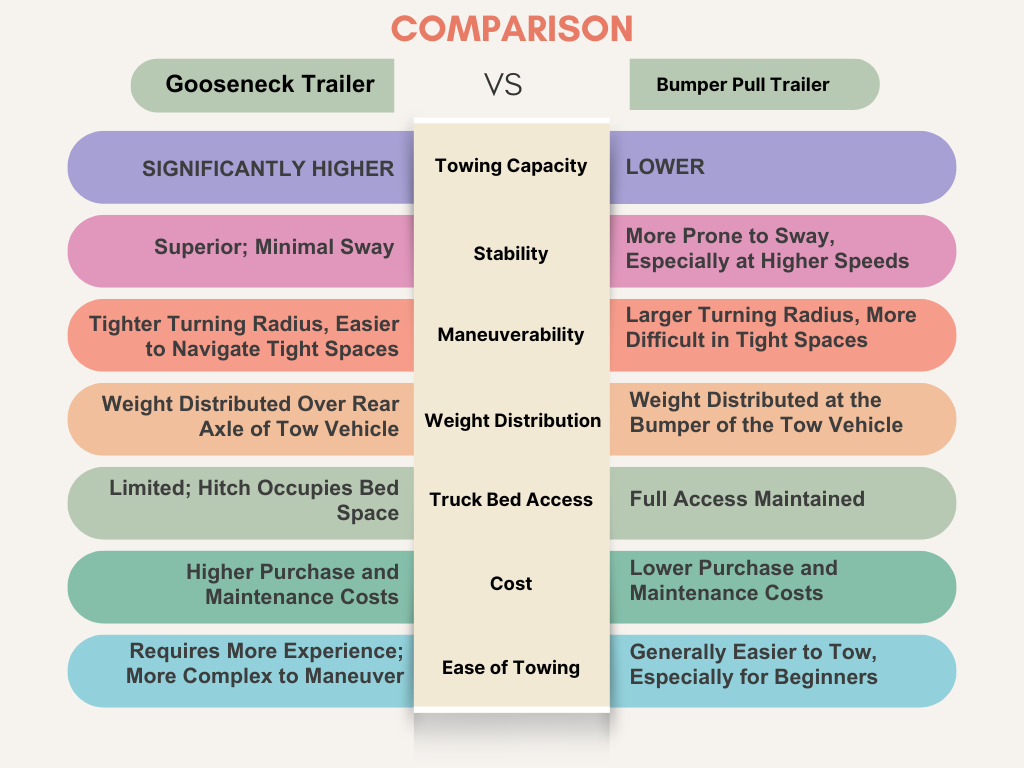
Choosing between a gooseneck and a bumper-pull trailer depends heavily on your unique hauling needs and towing capabilities. Both have distinct advantages and disadvantages, which we will explore in this section –
Gooseneck Trailers: Pros
Let us take a look into the advantages of gooseneck trailers –
1. Superior Towing Capacity:
Gooseneck trailers excel in heavy load handling. The centered weight distribution and strong hitch connection allow them to tow significantly more weight than bumper-pull trailers. It makes them ideal for hauling large equipment, livestock, and heavy machinery in construction and agriculture.
2. Enhanced Stability:
The gooseneck hitch sits directly over the tow vehicle’s rear axle and provides exceptional stability. It minimizes trailer sway, even at higher speeds, resulting in a smoother and safer towing experience.
3. Improved Maneuverability:
While still requiring careful maneuvering, gooseneck trailers offer a tighter turning radius than bumper-pull trailers. This is due to their close coupling to the tow vehicle, which makes it easier to navigate tight spaces and corners.
4. Better Weight Distribution:
The gooseneck hitch effectively transfers the trailer’s weight to the tow vehicle, improving traction and stability. It is crucial when hauling heavy loads, especially in challenging terrain.
Gooseneck Trailers: Cons
A set of advantages always offers equivalent cons that need effortless managing –
1. Limited Truck Bed Access:
The gooseneck hitch significantly limits access to the truck bed. Loading and unloading cargo can be more challenging and require additional equipment or techniques.
2. Higher Cost:
Gooseneck trailers are generally more expensive to purchase and maintain than bumper-pull trailers.
3. Installation Requirements:
Installing a gooseneck hitch typically requires truck bed modifications, which may affect its warranty.
4. Maneuverability Limitations:
Despite their improved maneuverability compared to bumper-pulls, gooseneck trailers require careful maneuvering in tight spaces and around obstacles.
Bumper Pull Trailers: Pros
Now let us talk about the other popular alternative in the market – bumper pull trailers –
1. Lower Cost:
Bumper-pull trailers are significantly more affordable to purchase and maintain than gooseneck trailers.
2. Easier to Tow:
Bumper-pull trailers are generally considered easier to tow, especially for beginners. They follow the path of the tow vehicle closely, making them more predictable to handle.
3. Greater Truck Bed Access:
Full access to the truck bed is maintained, allowing for easier cargo loading and unloading.
4. Versatility:
Bumper-pull trailers are highly versatile and can be used for various hauling tasks, from transporting recreational vehicles and boats to moving furniture and equipment.
Bumper Pull Trailers: Cons
Similar to gooseneck trailers, bumper pull ones have their set of disadvantages –
1. Limited Towing Capacity:
Bumper-pull trailers have a lower towing capacity than gooseneck trailers. They may not be suitable for hauling very heavy or bulky loads.
2. Reduced Stability:
Bumper-pull trailers are more prone to sway, especially at higher speeds. This can make towing less comfortable and potentially dangerous.
3. Limited Maneuverability:
Bumper-pull trailers can be more challenging to maneuver in tight spaces due to their longer wheelbase and greater turning radius.
4. Tow Vehicle Limitations:
The tow vehicle must have sufficient towing capacity and a suitable hitch receiver to accommodate the weight and size of the bumper-pull trailer.
Ultimately, the best choice between a gooseneck or bumper pull trailer depends on individual needs and circumstances. Consider the following factors when making your decision –
1. What is the weight and size of the heaviest loads you anticipate hauling?
What is the towing capacity and payload of your tow vehicle? Does it have the necessary hitches and features for either type of trailer?
2. How often will you be navigating tight spaces or narrow roads?
What is your budget for purchasing and maintaining a trailer?
3. How comfortable are you with towing? Do you prefer a bumper-pull’s simplicity or a gooseneck’s enhanced stability?
By carefully considering these factors, you can decide the best trailer type for your specific needs. Gooseneck attachment or bumper pulls have advantages and disadvantages. The former excels in towing heavy loads with exceptional stability, while the latter is more affordable and easier to tow.
Difference between Gooseneck And Bumper Pull
Let us browse this quick overview of the differences between a gooseneck and a bumper pull trailer.
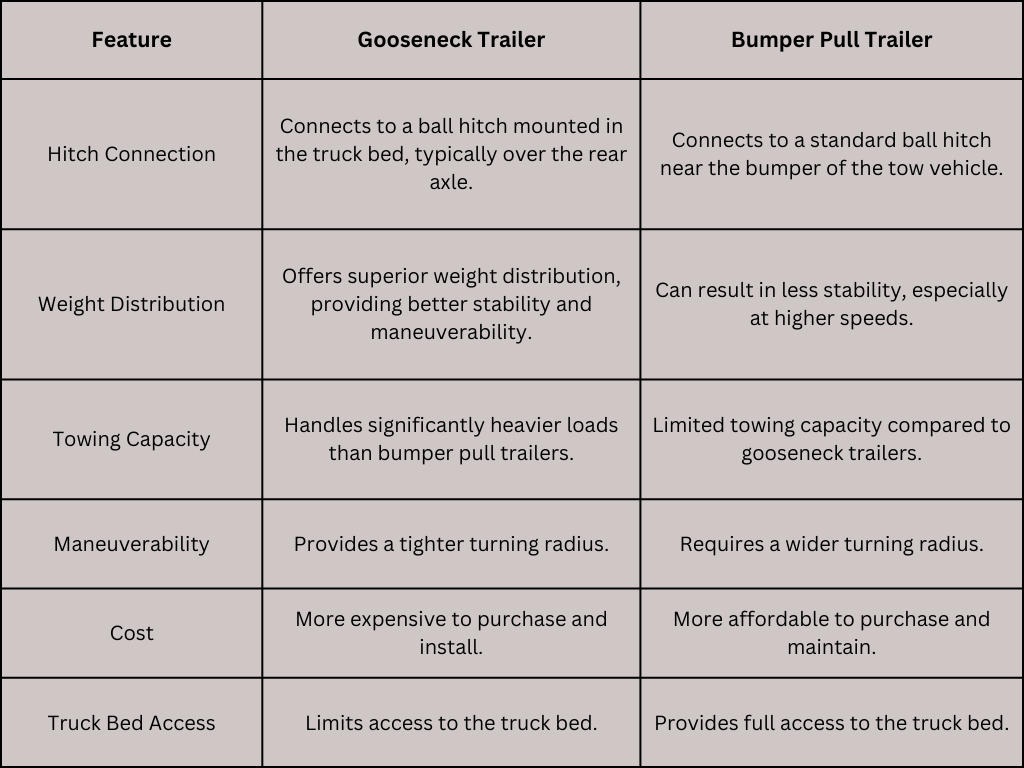
Gooseneck Trailers
- Hitch Connection:
The trailer’s tongue connects to a ball hitch mounted in the tow vehicle’s bed, typically over the rear axle. - Weight Distribution:
Offers superior weight distribution, resulting in more excellent stability and maneuverability. - Towing Capacity:
It can handle significantly heavier loads than bumper-pull trailers. - Maneuverability:
Generally provides a tighter turning radius compared to other trailer types. - Cost:
It is more expensive to purchase and install. - Truck Bed Access:
It limits access to the truck bed.
Bumper Pull Trailers
- Hitch Connection:
The trailer’s tongue connects to a standard ball hitch from the tow vehicle’s frame near the bumper. - Weight Distribution:
It can lead to less stability, especially at higher speeds. - Towing Capacity:
It is limited compared to gooseneck trailers. - Maneuverability:
It has a wider turning radius. - Cost:
It is more affordable to purchase and maintain. - Truck Bed Access:
It provides full access to the truck bed.
So, in summary, gooseneck trailers are ideal for hauling heavy loads and offer superior stability and maneuverability. Bumper-pull trailers are more affordable and easier to tow but have limitations in terms of towing capacity and stability.
Which one is right for you?
The choice between gooseneck and bumper pull depends on your specific hauling needs and towing capabilities. To make the best decision, consider factors like towing capacity, budget, maneuverability, and ease of use.
Trailer Maintenance Tips
Trailer maintenance is critical and applicable to gooseneck and bumper pulls equivalently. Here is a simple and quick checklist that keeps the vehicle long-running and in excellent condition –
1. Always keep the tires in check
Every trailer type offers the ideal tire pressure mentioned in the handbook. Ensure a weekly check of the tire, its conditions, any instances of damage, and pressure levels. A low-pressure trailer tire, when excessively used, can lead to unprecedented damage.
2. Inspect the lights and signals
Functional lights ensure road safety and protect you during heavy or unruly traffic. Additionally, they are crucial for your fellow drivers. Keep the taillights, brake lights, and turn signals in check and ensure they are clearly visible from afar.
3. Keep the brakes in check
Like the lights, brakes are essential safety elements – for you, the trailer, and fellow drivers. Inspect the brake components thoroughly for signs of damage. You may also perform a spin test by jacking off the trailer base.
4. Hitch and Coupler Check
Whether a gooseneck attachment or a bumper pulls one, be sure it is towed to the vehicle and in good condition. Signs of rust, damage, or crack demand immediate attention.
An ill-fitted coupler mechanism has long been the cause of devastating trailer mishaps. For effective guidance, seek help from bumper or gooseneck trailer manufacturers.
Frequently Asked Questions (FAQs)
Here are commonplace queries regarding bumper pull and gooseneck trailers –
How to pull a gooseneck trailer with a bumper hitch?
You CANNOT directly pull a gooseneck trailer with a bumper hitch. Gooseneck trailers require a specialized hitch mounted in the truck’s bed, not on the bumper.
What is a gooseneck adapter for a bumper pull trailer?
A gooseneck adapter is NOT a device that allows you to tow a gooseneck trailer with a bumper hitch. It is a misconception. Gooseneck trailers and bumper-pull trailers are fundamentally different and require different towing setups.
How wide is a gooseneck trailer?
The width of a gooseneck trailer varies depending on its purpose and the regulations in your area. However, regular widths for gooseneck trailers include –
Single-axle trailers: Typically around 8 to 8.5 feet wide.
Tandem-axle trailers: Can be wider, often reaching 9 to 10 feet or more.
Is a Gooseneck Better Than a Bumper Pull?
Whether a gooseneck is “better” than a bumper pull depends on your needs and the towing situation. Here is a comparison:
- Gooseneck:
Superior towing capacity, better stability, tighter turning radius. However, it is more expensive, has limited truck bed access, and requires a specialized hitch. - Bumper Pull:
It is more affordable, easier to tow, and has full truck bed access. However, its towing capacity is low, and it is less stable with a wider turning radius.
Should I use a gooseneck adapter to modify my bumper pull trailer?
You cannot modify a bumper-pull trailer to use a gooseneck adapter. The design has different hitching mechanisms and structural requirements.
Gooseneck trailers and bumper-pull trailers are distinct types with their advantages and disadvantages. Choose the one that best suits your specific hauling needs and towing capabilities.
Choosing the Right Trailer for Your Needs!
This comprehensive debate about gooseneck vs bumper pull is almost over, and we have arrived at the decision-making point.
A gooseneck trailer has pros and cons and has a greater tow capacity. You can access improved weight distribution and stability while handling larger cargo. However, the maneuverability is a bit of a hitch for the gooseneck.
The bumper pull trailer, however, is beginner-friendly. The features are less cumbersome to understand and can be utilized in tight spaces.
If your business needs revolve around large loads, such as huge livestock numbers or massive construction elements, we suggest the gooseneck. However, if your towing is around a hobby level and you have less space to begin with, a bumper trailer works superbly.
Whatever you need, Top Shelf Trailers is here to offer you some top-rated and premium-designed trailers for hauling essentials. We are one of the best bumper trailer and gooseneck trailer manufacturers in the United States, trusted by countless businesses!

